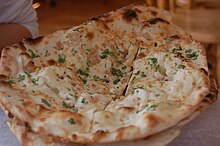Atta (flour)
| Place of origin | India, Pakistan |
|---|---|
| Region or state | Indian subcontinent |
| Associated cuisine | North India and Pakistan |
Atta or chakki atta is a wholemeal wheat flour, originating from the Indian subcontinent, used to make flatbreads such as chapati, roti, naan, paratha and puri.[1] It is the most widespread flour in India and Pakistan.[2]
Properties


Hard wheats, used to make atta, have a high gluten content, which provides elasticity, so doughs made out of atta flour are strong and can be rolled out into thin sheets.[1][3]
Atta was traditionally ground in the home on a stone chakki mill. Because this stone milling technique is still used (now typically at industrial scale), atta has more damaged starch than roller milled wheat flours, making the dough sticky.[1] This is useful when using a tandoor, where the flatbread is stuck to the inside of the oven, and also makes chapatis softer as the dough absorbs more water.[1][2]
Gallery
-
Rolling of atta dough
See also
References
- ^ a b c d "Atta". Bakerpedia. Retrieved 17 August 2018.
- ^ a b Mollenhauer, Martina; Popper, Lutz (4 November 2017). "From flatbread to sandwich loaf". World-Grain.com. Retrieved 17 August 2018.
- ^ Atta - Indian Wholewheat Flour (Food-india.com)
Further reading
- Reddy, J.; Weinmann, S.; Heine, D.; Conde-Petit, B. (8 August 2012). "A new standard for the industrial production of high quality Atta flour". Quality Assurance and Safety of Crops & Foods. 4 (3): 151. doi:10.1111/j.1757-837X.2012.00160.x.




